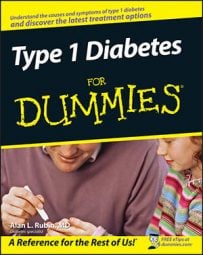Essential doctor's office visits and tests for people with type 1 diabetes
Undergoing tests at the doctor’s office is a fact of life for someone who has type 1 diabetes. But with this handy card, keeping track of test results is a snap. You can make copies of this chart and fill in your child’s (or your own) results.
| Test | Frequency | Results |
|---|---|---|
| Foot exam | Each office visit | |
| Blood pressure | Each office visit | |
| Weight | Each office visit | |
| Height | Each office visit | |
| Hemoglobin A1c | Every three months | |
| Thyroid-stimulating hormone (TSH) | Yearly | |
| Microalbuminuria | Yearly | |
| Eye exam | Yearly | |
| Lipid panel (cholesterol) | Yearly | |
| Ankle-brachial index | Every five years |
Recognizing and treating hypoglycemia in children
There are many possible causes for hypoglycemia in children with type 1 diabetes, but it all really comes down to too much insulin (from an external source) and too little glucose in the blood.
Even if there’s plenty of glucose inside the cells that require insulin, a problem still exists because the brain gets its glucose passively when the glucose in the blood is higher than the glucose in brain cells.
If insulin has driven most of the blood glucose into cells that don’t receive glucose passively, hypoglycemia is present as far as the brain is concerned. And that means the child becomes confused, sleepy, and even comatose.
Some symptoms of hypoglycemia are:
-
Whiteness or pallor of the skin
-
Sweating
-
Rapid heartbeat or palpitations (the sensation that the heart is beating too fast)
-
Anxiety
-
Irritability
-
Numbness in the lips, fingers, and toes
-
Sensation of hunger
-
Headache
-
Loss of concentration
-
Vision disorders, like double or blurred vision
-
Poor color vision
-
Fatigue
-
Difficulty hearing
-
Confusion and difficulty concentrating
-
Feeling of warmth
-
Slurred speech
-
Dizziness
-
Convulsions
-
Reduced consciousness or coma
Mild hypoglycemia is marked by a blood glucose of about 75 mg/dl, moderate hypoglycemia by a blood glucose of about 65 mg/dl, and severe hypoglycemia by a blood glucose of less than 55 mg/dl.
You can prevent many episodes of hypoglycemia by constantly staying aware of your child’s blood glucose and keeping him on a regular schedule; you can adjust his insulin if he’s mildly hypoglycemic. Other tips for treating hypoglycemia include the following:
-
Giving your child glucose tablets, which contain 4 mg of glucose. Two to four tablets is enough for moderate hypoglycemia in most children. If your child has trouble swallowing, give him honey instead of glucose tablets.
-
Giving your child 1-1/2 cups of orange juice. It effectively raises the blood glucose back to the normal range of 90 to 100 mg/dl.
-
Keeping the child quiet and inactive for 15 to 30 minutes after the reaction.
-
Checking the blood glucose 20 minutes after treating the hypoglycemia and giving another treatment if the level remains below 100 mg/dl.
-
Using a prescription glucagon emergency shot for an unconscious child who has severe hypoglycemia. Just make sure that the glucagon hasn’t expired. If the child doesn’t wake up in 10 to 15 minutes even though his blood glucose is normal, call 911.
Taking action if diabetic ketoacidosis strikes
Diabetic ketoacidosis (DKA) is a severe diabetic complication that has to be managed in a hospital. It’s characterized by high blood glucose (though it need not be very high) associated with an acid condition of the blood due to the production of ketones, which are the products of fat breakdown. The root of the illness is a lack of insulin.
Without enough insulin, glucose can’t get into insulin-dependent cells like muscle and the liver, so glucose accumulates in the blood, and the body turns to fat for energy.
Major symptoms include the following:
-
Abdominal pain
-
Frequent urination and thirst
-
Nausea and vomiting
-
Weakness
-
Weight loss
-
Smell of acetone on the breath
-
Confusion or coma
-
Cold skin and body temperature
-
Rapid, shallow breathing followed by deep, labored breathing
If you suspect that you or your child has DKA, there are a couple of quick tests you can do at home to verify the diagnosis:
-
Check the blood glucose with your home meter. With DKA, the meter will generally read greater than 250 mg/dl, but some cases of mild DKA may have a glucose reading under 250 mg/dl.
-
Check the urine for ketones. With DKA, the reading will be high.
After you verify DKA with a home test, or if you suspect that you or your child has DKA even without a diagnosis of type 1 diabetes, dial 911 and then call your doctor to tell them that you’re on the way to the hospital.

